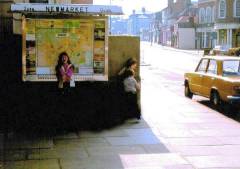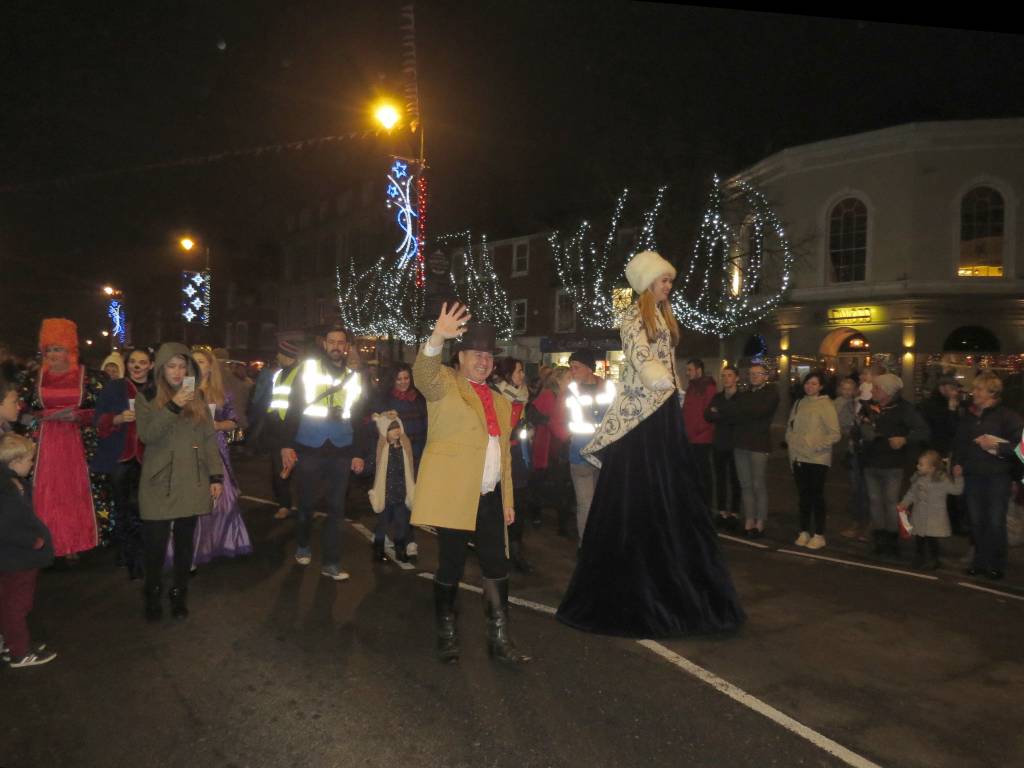
|
Explore the Past to Understand the Present and Shape the Future |
|
If you're looking for any particular detail about a shop, house or person associated with the history of Newmarket, enter the details in the box below and click 'Google Search' ... | |||||
|
|
|||||
Does
anyone in Newmarket remember the illuminated Street Map
outside the Post Office in the High Street? On this you could press a selection of buttons that illuminated various sites-of-interest around the town. This web site works in a similar way - if you click on the small map on the right, a full page map will appear that can be clicked-on at various highlighted positions to then show the history of that location. |
|
 Just like the real town this web site is a place to be explored - clicking on the blue text on any page will take you to another nook & cranny in the history of Newmarket Shops. |
|||
|
|
|||||
|
NEWMARKET LOCAL HISTORY SOCIETY ... click above to visit the NLHS website for a detailed history of Newmarket ... |
|
 Click above to see an 1886 Map of Newmarket |
 Click above to take a walk down the southern side of the High Street |
... click above to visit Newmarket Shops History on Facebook |
|
|
Slice in Time
... or click above to visit the |
 Click above to see a 1926 Map of Newmarket |
... or click above to visit the Old Newmarket Facebook page for a wonderful selection of photos showing the history of Newmarket ... |
|||
If you have any questions about or
are able to contribute to any details on this web
site please -
E-MAIL

|
|||||
 Queen's visit to Newmarket - 3rd November 2016 Click HERE to see more photos |
|
|
|
|

|
|

|
|

|
|

|
|

|
|

|
|

|
|

|

|

|
|

|
|

|
|

|
|

|
|

|
|

|
|
|
For previous front page photos visit the Photo Gallery Page | |
Newmarket RacingThough it's from a Newmarket-centric personal viewpoint (and some will dispute this), over at least the last three and a half centuries, Newmarket has evolved to become the world-wide centre of Thoroughbred horseracing. Home to the offices of the largest commercial organisation in British horseracing: the Jockey Club, plus the location of one of the world’s most internationally renowned Thoroughbred auctioneers: Tattersalls, and also with its many other highly successful racing establishments, Newmarket has in the eyes of many, become the horseracing capital of the world.In a simplistic view, and in addition to the Jockey Club offices and Tattersalls, there are essentially three basic types of horseracing establishments that have grown up in and around Newmarket. Firstly there's the Studs: where Mares (females) are covered by Stallions (Males) and the Foals (babies) are born - hundreds each year, requiring thousands of acres of secluded, closely mown, green paddocks to live their quiet and gentle early lives. These tend to be located (though not universally, and this has changed over the years) further out from the town, with a variety of studland occupying a cluster of villages and locations around Newmarket. Secondly there's the Stables, and in Newmarket these are mostly training stables. These are generally located close to Newmarket's heathland: the Cambridge and the Bury / Moulton Heaths. Additional thousands of acres of cut grasslands, with gallops that aim to simulate the racecourse environment and facilitate the honing of the slightly older young horses up to what's hopefully the pinnacle of their racing careers. Newmarket isn't isolated in the world-wide racing community though and over the years many highly influential personnel and horses have been attracted to its ably capable facilities. Of particular early interest to the racing community is the family of George Dawson of Gullane in Scotland, with his four very famous race-horse trainer sons, three of them having training stables in Newmarket - Mathew, Joseph and John - details about them can be found on the page 'The Dawson Family'. Then there's also Bedford Lodge in Bury Road - this extensive site has seen a wondrously complicated history intertwined with racing tradition. One other of the racing families, who at one time had a member occupying part of the Bedford Lodge site, was that of the Leader family: father Tom and sons Thomas Richard, Fred, Colledge, Stephen and Harvey - details about them can be found on the page 'The Leader Family'. Finally in the list of Newmarket's racing establishment, of course we mustn't forget the town's 'Jewel in the Crown' - its racecourses: the Rowley Mile and the July. Details of their history, how they've evolved over the years, and their intimate links to the town can be found on the page - 'Newmarket's Racecourses'. And then of course I'm sure that they wouldn't us to forget them in this Thoroughbred horseracing panorama, we have the National Horseracing Museum, presently located at No.99 High Street, though soon to relocate in the Autumn of 2016 to a new headquarters and become the National Heritage Centre for Horseracing & Sporting Art, located in the recently refurbished house and stables of the former King Charles II's Palace in Palace Street. [Note from webmaster - my maternal Granddad worked at a stud - Eve Stud at Woodditton - details about him and his main charge; the 1953 Derby winner Pinza, can be found on the page for Bedford Lodge. My paternal Great Grandfather came to Newmarket some time during the 1870s to work at a racing stables, most probably Palace House Stables - details about him can be found on the page for King Charles II's Palace.] Newmarket HeathAlthough clearly the swathes of heathland around Newmarket have always been very strongly associated with it's racing industry, right from its early days, they have also had other lives ... and during WWII the heath to the west of the town became RAF Newmarket ... which even took over the Rowley Mile Course for use as its base.Unfortunately amongst its many successes during that campaign RAF Newmarket was also at the centre of a variety of air crashes. Further details about all this can be found on the page for Newmarket Heath. |
|||||||||
| Key events in history |
Kings
& Queens of England from Elizabeth I to Elizabeth II | ||||||||
|
1577 1585 1585-1604 1620 1642-1651 1660 1665 1666 1770 1775-1783 1803-1815 1804 1805 1815 1851 1854-1856 1861-1865 1873 1876 1878 1879 1880-1881 1893 1888 1891 1899-1902 1903 1906 1914-1918 1927 1939-1945 1948 1963 |
Sir Francis Drake's world voyage Sir Walter Raleigh's American colony Anglo-Spanish War Pilgrim Fathers voyage to America English Civil War The Restoration Great Plague of London Great Fire of London Capt James Cook lands in Australia American War of Independence Napoleonic Wars First steam train Victory at Trafalgar The Battle of Waterloo Photography popularised Crimean War American Civil War First QWERTY keyboard typewriter Birth of the telephone Invention of electric lamp Anglo-Zulu war First Boer War First petrol car Kodak box camera First motion picture camera Second Boer War First flight First radio broadcast First World War Armistice Day - 11th November 1918 First 'talkie' film Second World War VE Day - 8th May 1945 VJ Day - 2nd September 1945 British Railways nationalised Beeching Report on British Railways |
Elizabeth I James I Charles I Commonwealth Charles II James II William III & Mary II Anne George I George II George III George IV William IV Victoria Edward VII George V Edward VIII George VI Elizabeth II |
1558 - 1603 1603 - 1625 1625 - 1649 1653 - 1659 1660 - 1685 1685 - 1688 1689 - 1702 1702 - 1714 1714 - 1727 1727 - 1760 1760 - 1820 1820 - 1830 1830 - 1837 1837 - 1901 1901 - 1910 1910 - 1936 1936 - 1936 1936 - 1952 1952 - present | ||||||
|
clicking on the blue text on any page will take you to another page about the history of Newmarket Shops |
|||||||||
The Origins of NewmarketThe above chronology of milestone events and English royalty starts in 1558. By that time Newmarket was actually already well established, and although it took until 1605 with the royal patronage of King James I to start its evolution from being just a small village and instigating its subsequent elevated equestrian status, there's a wealth of historical events before then that have contributed to making Newmarket the town that it is today.Although not strictly about the shops themselves this history does help understand the topography of the area; why the town is located in a strange island between two counties and why there's a major road running straight through the centre of it ... an explanation of these details can be found on the page for the Origins of Newmarket. |
|||||||||
|
click on the above map to find out about the Origins of Newmarket. |
|||||||||
|
Sadly we recently had to say goodbye to a very good friend and constant contributor to the many old postcard images that can be found on this web site, including that shown above. Roger Newman died at the County Hospital, Stafford on 13th February 2015. Although he'd been living with his wife Norma in Staffordshire for some time he often visited Newmarket to attend the Newmarket Local History Society meetings and always made the effort to come and chat to me about various aspects of Newmarket's history. Not only did he own a prodigious collection of old postcards, images of which he willingly shared, but his personal knowledge of the town and its history was so helpful in compiling many of the details on this web site. His funeral was at 1 pm on Monday 2nd March 2015 at Stafford Crematorium. 
|
|||||||||
|
Many thanks to Tony Pringle for his help with this web site, particularly the many photos and histories of the pubs of Newmarket Click the pictures above or below to see Tony's own web site, dedicated to the lives lost during the wars and the vaarious local memorials. 
Exning Remembers Book Signing - Newmarket Library - 14th November 2013 |
|||||||||
|
|||||||||